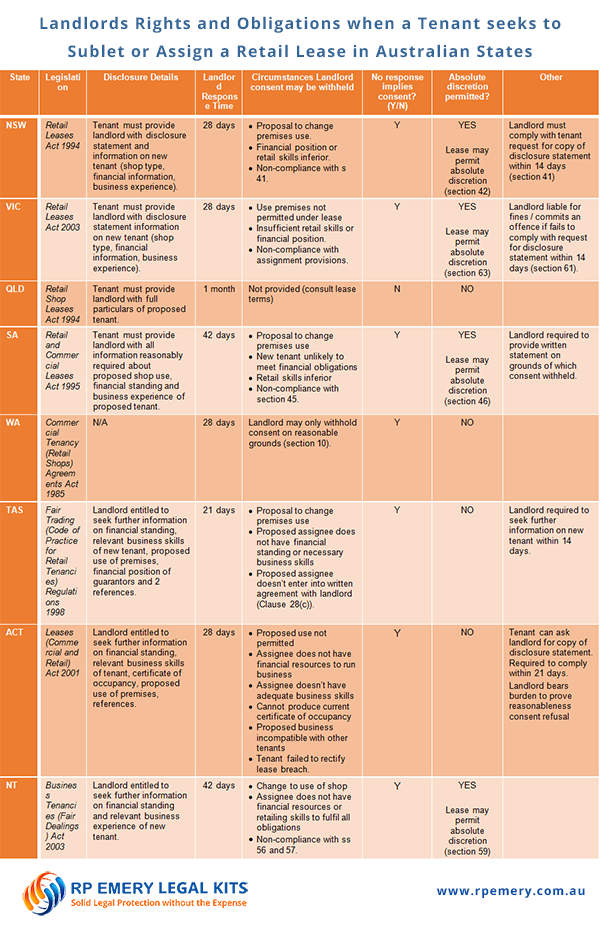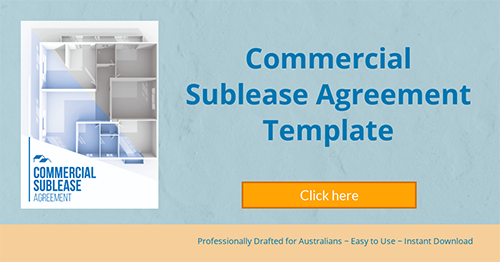Circumstances may arise when a tenant seeks to sub-let or assign their lease over retail premises. Especially in the so-called ‘sharing economy’, some retail stores are seeking to economise on space and real-estate costs. For example, the retail premises may be too large for their business needs or the lessee is seeking an alternative to terminating the lease. However, there are strict guidelines on method of seeking consent and whether the landlord is permitted to withhold their consent.
Assigning a lease
A tenant may assign their lease over a retail premises by transferring existing rights and obligations under the agreement to a third party. The original tenant essentially ‘steps out’ of obligations under the first lease and the new tenant ‘steps in’, becoming bound by the terms of the original lease.
>>> See Assignment of Lease Agreement
Subletting the property
Alternatively, when a lessee sublets the premises, they essentially form another lease agreement with a third party. Whilst the original lease and tenant obligations remain, the sub-tenant is given rights to exclusive possession over all or part of the premises. Therefore, whilst the original agreement still exists, a new agreement is formed between the head tenant and the sub-tenant. The head tenant is also liable to the landlord for damages or lease violations by the sub-tenant.
Landlord Consent
Legislation strictly limits the circumstances whereby a landlord may refuse consent to assign the lease or sub-let retail premises. Whilst written consent must be sought in all jurisdictions, there are differences between States with regards to:
- disclosure of proposed tenant’s details;
- landlord response time;
- circumstances where consent may be withheld; and
- whether a failure to respond automatically infers consent.
In New South Wales, a landlord cannot reasonably refuse a request to sublet or assign a lease, unless the use of the premises will change or the proposed tenant has inferior retail skills and / or financial resources. Additionally, NSW, VIC, SA, and NT legislation explicitly enables the landlord to refuse consent in their ‘absolute discretion’ if the lease terms permit. See the below table for more details.
If your tenant is seeking consent to sub-let or assign their retail lease, remember:
- Your tenant must comply with the legislation – including seeking consent in writing;
- Failure to respond may imply landlord consent;
- Be mindful that the landlord must respond within a certain timeframe;
- Check the terms of your lease whether ‘absolute discretion’ permitted;
- Generally cannot unreasonably withhold consent
- Consult the relevant legislation in your jurisdiction as to whether you can withhold consent and under what circumstances; and
- If you are unsure about consenting to sub-letting or assigning a lease over your retail premises, consult independent legal advice.
We have summarised the different rules in the table below or you can see the information on an Australian state by state basis by clicking the links below.
Or you can view this image – click it to enlarge
Other Resources about retail leasing in Australia
How to make sure your Retail Lease says what you mean
 Signing a retail lease is one of the most important business decisions you will make. It is therefore essential that your retail lease feature clear and explicit negotiated terms so that both parties are clear on how the lease is intended to operate. In other words you need to make sure that your lease says what you mean it to.
Signing a retail lease is one of the most important business decisions you will make. It is therefore essential that your retail lease feature clear and explicit negotiated terms so that both parties are clear on how the lease is intended to operate. In other words you need to make sure that your lease says what you mean it to.
How to Manage Outgoings in Commercial and Retail Lease Agreements
 When you lease a retail or commercial premises, you need to decide how you will manage the outgoings. Will they be charged as a separate amount or will they be added to the regularly monthly payment. This article helps you to determine which option you should choose.
When you lease a retail or commercial premises, you need to decide how you will manage the outgoings. Will they be charged as a separate amount or will they be added to the regularly monthly payment. This article helps you to determine which option you should choose.



